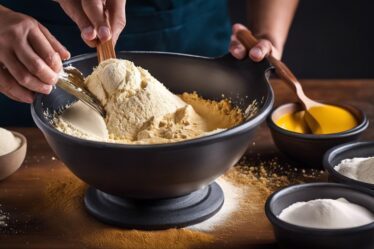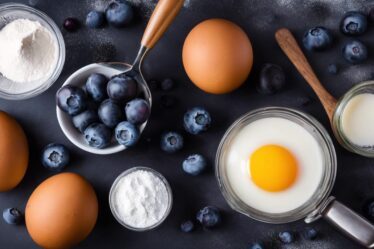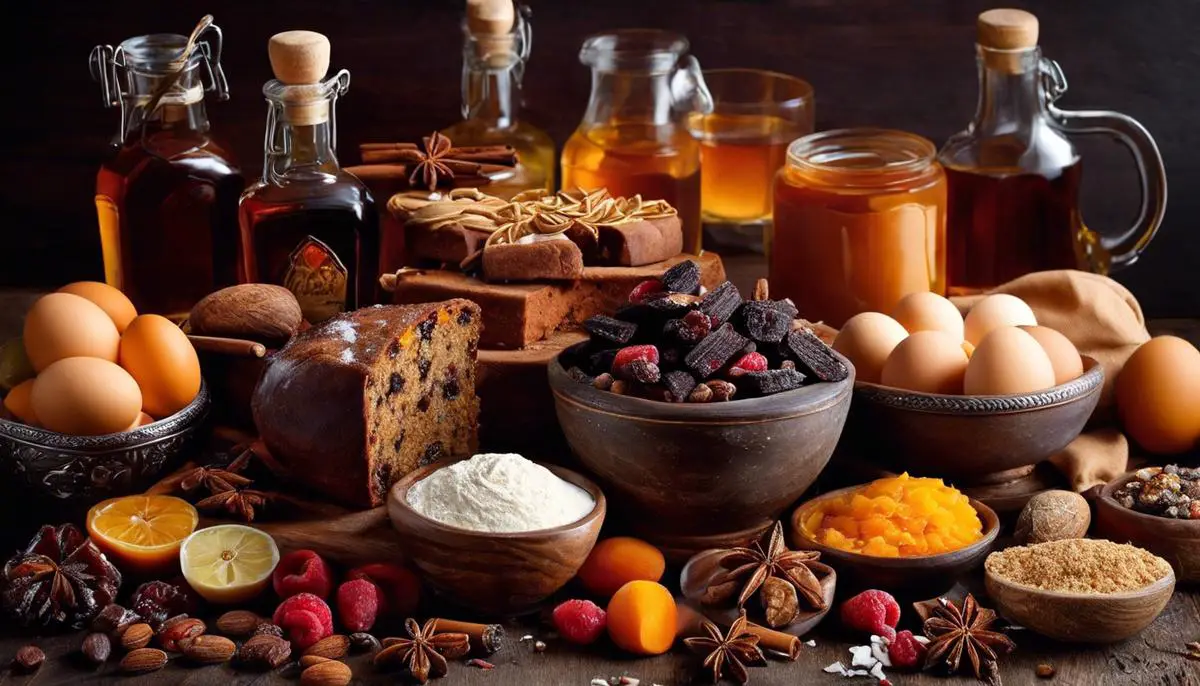
Just as tradition and festivity fill the air, the delightful aroma of a fruit cake baking in the oven adds to the sense of warmth and celebration. This flavorful delicacy is a hallmark of holidays and an embodiment of nurtured love, with each ingredient playing a crucial role in its preparation. We begin this enlightening journey by comprehending the ingredients essential to the cake’s creation, such as dried fruits, flour, butter, sugar, eggs, spices, and alcohol such as rum or brandy. Each element contributes significantly to the cake’s final texture, taste, and appearance. Furthermore, the precise baking process- from mixing the ingredients to the ideal temperature and time for baking- is meticulously detailed, carving out a practically foolproof guide for even beginners in the kitchen. Additionally, the aspects of ageing the fruit cake to intensify its characteristic flavors and the proper way to store it for longevity are covered comprehensively.
Understanding Ingredients
Headline: Essential Ingredients For a Perfectly Crafted Fruit Cake You’ll Love
Crafting the perfect fruit cake is a labor of love; a deeply satisfying endeavor that embodies our shared passion for wonderful tastes and textures, where every scrumptious bite connects us through a universal language — food. Who wouldn’t cherish the prospect of a moist, tender fruit cake? Rich in aromatic spices, bursting with juicy, flavor-packed fruits; a lusciously rich delight capable of transforming even a regular Tuesday afternoon into an occasion. It’s all about the right components coming together, so let’s talk about those absolute must-haves that construct the foundation of the perfect fruit cake.
Starting with the undeniable basis of any substantial cake, a binding combination of flour, baking powder, and salt sets the stage. Bread flour, beloved for its protein-rich nature that equates to a sturdier structure, tempers the fruity density of this lavish treat. Baking powder lends its lifting power, while salt strikingly contrasts the sweetness and amplifies every flavor.
A trio of batter basics, brown sugar, butter, and eggs, infuse the cake with decadence. Brown sugar adds an exquisite depth with its molasses hints. Choosing unsalted butter promises richness without overshadowing other ingredients. While eggs – essential talent multi-taskers – work to increase leavening, give structure, and extend shelf life, thereby guarantying each last morsel remains just as sublime.
Never overlook the aromatic beauty of spices. Nutmeg, cinnamon, and allspice conjure up a heartwarming coziness that melds effortlessly into the fruit cake milieu. Don’t skimp on the alluring power of vanilla extract either; it has a magical ability to enhance other flavors in baked goods.
Oh, and the fruits – the crown jewel of this affair! A colossal assortment of candied, dried, and glazed fruits contribute to the complex, layered taste that puts the ‘fruit’ in fruit cake. Think candied peaches, dried apricots, cherries, raisins, and more.
However, let’s not forget the humble nut. Typically, crunchy almonds or hearty pecans are tossed in for texture contrast, simultaneously providing a counterbalance to the sweetness.
Alcohol, often brandy or rum, is the secret ingredient of many a fruit cake. It plays two roles: first, it macerates the fruits, unlocking their full flavor profile. Then, post-baking, it’s drizzled over the finished creation, imparting a tantalizing, adult twist. If alcohol doesn’t fit your palate, apple juice or orange juice provide a similarly zingy moistening effect.
Wrapping it up with a top-tier tradition, a final, ornamental layer of marzipan and royal icing augment the allure of a classic fruit cake. While entirely optional, there’s no denying that it adds a unique, festive touch, inviting us to slice into its goodness.
Intricately woven within the fabric of our culinary cultures, the eraless art of baking a fruit cake becomes a veritable symphony of flavor with just the right ingredients. Each brings its personality to the table, conjuring the perfect harmony between sweetness, savoriness, and spice, in that perfectly moist bite of homemade fruit cake. When shared with friends and family, it becomes more than just a cake; it paints a delightful experience built around the joy of good food and great company. That’s a treasure certainly worth the time spent in our beloved kitchens!
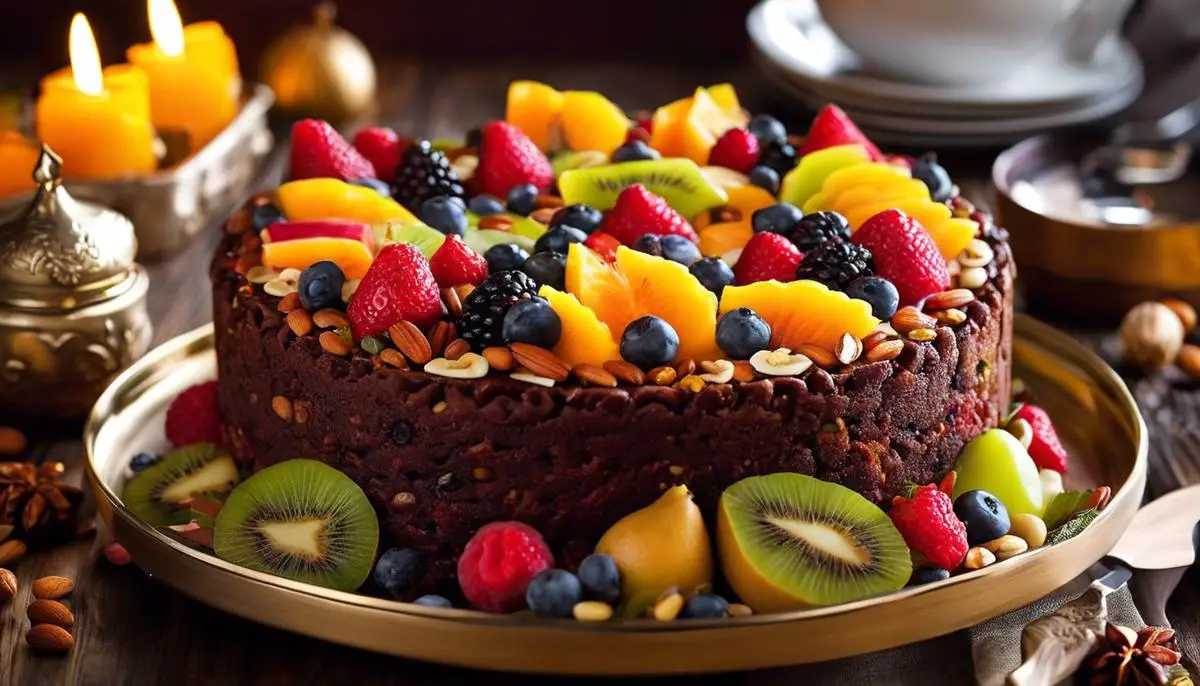
Baking Process
Delving further into the artistry of piecing together a delectable fruit cake, let’s address one of the most crucial steps—baking.
This process requires a pre-heating oven at 325 degrees Fahrenheit for conventional ovens, and 300 degrees for convection ones. A cake tin should ideally be lined with greased parchment paper, double-layered to aid even cooking and prevent the sides from browning too quickly.
In preparation, the creamy, buttery, and spicy mixture needs to be spooned into the tin, smoothed out, and tapped gently to get rid of any air bubbles. The top is often adorned with a spattering of blanched almonds for crunch and aesthetic appeal.
The initial phase of baking takes 45 minutes. Then, lay a tenting foil over the cake—this regulates temperature and ensures the top doesn’t overcook while the inside is still doing its magic. The full baking time typically varies from two to two and a half hours. Remember, patience is critical in this entire baking process. Keep in mind, each oven behaves differently, so it’s important to keep a watchful eye.
Inserting a skewer into the cake, if it comes out clean, means your precious endeavor is complete. Although removing the cake should happen while it’s warm, it should stay in its tin until cool. It may seem odd, but embracing this two-step process safeguards the structure and moisture of the cake.
Post baking, the cake should be perforated in several places and liberally brushed with your chosen tipple—either brandy or rum. The careful application of alcohol adds to the longevity of the cake, preserving it and making it more delightful as days pass.
When it comes to serving the cake, it should be at room temperature to fully enjoy the warming bite of nutmeg, the kick of cinnamon, the dark sweetness of the fruits, and the mellow caress of alcohol. To top it all off, the cake is usually enveloped in an almond-scented marzipan layer and crowned with glossy swirls of royal icing—a joyous display of colors and textures.
Back to your loved ones. Unveiling your masterpiece, slicing through layers of flavors, and savoring together is a humbling experience. A fruit cake is more than a dish; it’s an event. It represents labor, love, patience, tradition, and unity—connecting us through the shared act of eating, relishing and celebrating. After all, food is the language we all speak. And if you’re eager to reciprocate the love, why not share your baking secrets? The act of passing down recipes, much like the humble fruit cake, is essentially passing down stories, memories, and love. As is said in the world of gourmets, the secret ingredient is always love. And maybe a dash of brandy.

Ageing and Storage
Moving beyond the making of the fruit cake and onto the next delightful step — aging and storing it properly. This is a crucial part of the process that takes your blissfully baked cake from a simple sweet treat to a gastronomic gem brimming with complex flavors.
This may seem like a waiting game, but it’s all part of the fruit cake’s charm. The aging process permits a harmonious marriage between the flavors, as the fruits, nuts, spices, and alcohol all intertwine so beautifully. A well-aged fruit cake, when served, will prompt an “ooh” or an “aah” from your dinner guests as they savor every morsel.
Start the aging process by drenching the cake with your chosen alcohol. This not only contributes to the aging and flavor development but also helps preserve the cake. Using a clean skewer, perforate the cake and brush it with rum or brandy. This experiment should be repeated every two weeks for about two months.
For the storage, wrap your cake in a cheese or butter cloth soaked in the same alcohol used for the cake. This will ensure that the cake will continue to moisten and the flavors will become more integrated over time. Next, wrap the cheesecloth-covered fruit cake in aluminum foil, thwarting any air from entering and drying it out.
The cake should then be stored in a cool, dark place. A pantry or a bottom drawer is often the perfect hideaway. If you’re short on space, the back of a closet will do. Take caution in storing the cake in a refrigerator as this can often result in the cake losing its natural moisture.
Remember: aging a fruit cake can take anywhere from two months to a year. So, if you want it ready for the holidays, planning and baking ahead is key. Also, bear in mind that a properly stored fruit cake will taste as good as new even after a year!
But remember, in the spirit of shared joy, never age a cake in absolute solitude. Share these meticulous details with other baking enthusiasts in your life or better yet, involve them in the entire process. After all, food is more than just a meal on the table—it’s the stories we share and the connections we make that truly warm our hearts!
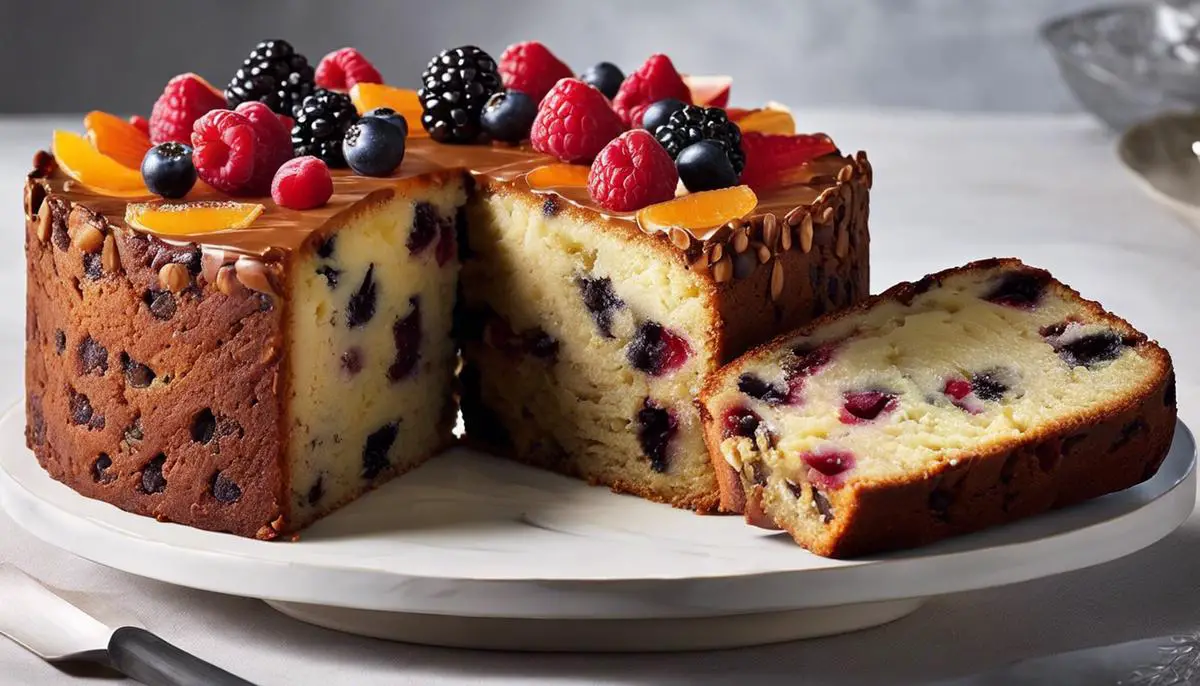
The magic of fruit cake isn’t just in its delicious taste but also in the process of its creation- the careful selection and combination of ingredients, the meticulous preparation, and the patience in baking and aging. These factors unite and contribute to a culinary masterpiece that speaks to the heart and comforts the soul. Such is the beauty of understanding the craft behind a well-made fruit cake; it not only enriches your culinary skills but deepens your appreciation of this timeless dessert. So the next time you savor a slice of your homemade fruit cake, remember, you’re partaking in a tradition that’s been passed down through generations, and now, you are a part of that lineage, bringing joy and festive spirit to your table with each delicious bite.

